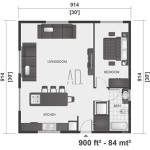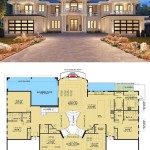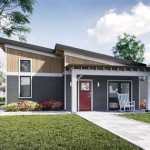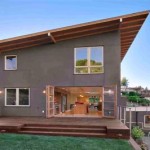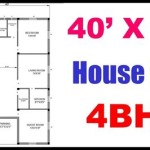Cabin With Loft Floor Plan: Maximizing Space and Charm
Cabin living embodies the allure of simplicity, nature, and a retreat from the complexities of modern life. When designing a cabin, particularly a smaller one, optimizing space is paramount. The cabin with loft floor plan emerges as a popular solution, offering a functional and aesthetically pleasing way to enhance living areas without significantly increasing the building's footprint. This design leverages vertical space, creating a more expansive feeling and providing distinct zones for various activities. Understanding the nuances of a cabin with loft floor plan is crucial for homeowners seeking a balance of practicality, comfort, and rustic appeal.
The primary advantage of a loft cabin floor plan lies in its ability to separate sleeping quarters from the main living areas. This separation contributes to a more peaceful and organized living environment. By elevating the sleeping area, the ground floor becomes available for an open-concept living room, kitchen, and dining space. This design fosters a sense of spaciousness and facilitates social interaction, making it ideal for both solo retreats and family gatherings. The utilization of vertical space also allows for the inclusion of features that might otherwise be omitted in a single-story cabin, such as a larger kitchen island or a more comfortable seating arrangement.
Furthermore, the loft area itself can be customized to suit individual needs and preferences. It can function as a master bedroom, a guest bedroom, a home office, a reading nook, or even a children's play area. The versatility of the loft space makes it a valuable asset in a cabin design, allowing homeowners to adapt the space to their changing lifestyles and requirements. Appropriate planning and consideration for factors like headroom, access, and natural light are key to maximizing the functionality and comfort of the loft space.
Key Considerations for Loft Design: Headroom, Access, and Safety
Headroom is a critical factor to consider when designing a loft. Inadequate headroom can make the loft feel cramped and uncomfortable, negating the benefits of the design. Building codes often specify minimum headroom requirements for habitable spaces, and these regulations should be strictly adhered to. However, even if a design meets code requirements, ensuring sufficient headroom for comfortable movement and use is essential. This usually involves carefully planning the roof pitch and the overall height of the cabin. The intended use of the loft space will also influence the required headroom. A sleeping area may require less headroom than a home office where occupants will be standing or sitting for extended periods.
Access to the loft is another crucial design consideration. The most common methods of accessing a loft are stairs and ladders. Stairs offer a more comfortable and safer option, particularly for older individuals or those with mobility issues. However, stairs require more floor space, which may not be available in a small cabin. Ladders are a more space-efficient option, but they can be less convenient and potentially more hazardous, especially for frequent use or during emergencies. A well-designed ladder should be sturdy, angled for easier climbing, and equipped with handrails. Spiral staircases can also be considered as a compromise between space efficiency and ease of use, but they may still require more space than a ladder. The choice of access method should be carefully considered based on the available space, the users' needs, and safety considerations.
Safety is paramount when designing a loft. Guardrails or railings are essential to prevent falls from the loft edge. Building codes typically specify minimum height requirements for guardrails, and these requirements must be met. The design of the guardrail should also consider safety, ensuring that there are no gaps large enough for a child to fall through. Furthermore, smoke detectors and fire extinguishers should be installed in both the loft area and the main living area to provide early warning and firefighting capabilities in case of a fire. Escape routes should be clearly defined and accessible, ensuring that occupants can safely evacuate the cabin in an emergency. The placement of windows in the loft can also enhance safety by providing an alternative escape route.
Optimizing Natural Light and Ventilation in Cabin Lofts
Adequate natural light and ventilation are essential for creating a comfortable and inviting loft space. Natural light enhances the ambiance of the loft, making it feel brighter and more spacious. Well-placed windows can also provide scenic views of the surrounding landscape, enhancing the overall experience of the cabin. The size and placement of windows should be carefully considered to maximize natural light while minimizing heat gain in the summer and heat loss in the winter. Skylights can also be an effective way to bring natural light into the loft, particularly in areas where wall windows are not feasible. However, skylights should be properly insulated to prevent condensation and heat loss.
Ventilation is crucial for maintaining air quality and preventing moisture buildup in the loft. Proper ventilation can help to regulate temperature, reduce humidity, and remove stale air. Windows that can be opened are the most effective way to provide natural ventilation. The placement of windows on opposite sides of the loft can create cross-ventilation, allowing for a natural flow of air. Ceiling fans can also be used to circulate air and improve ventilation, particularly in areas where natural ventilation is limited. In some cases, mechanical ventilation systems may be necessary to ensure adequate air quality, especially in tightly sealed cabins or in climates with extreme temperatures.
The orientation of the cabin can also affect the amount of natural light and ventilation that the loft receives. A cabin oriented towards the south will receive more sunlight during the winter months, while a cabin oriented towards the east or west may receive more glare and heat during the summer months. The placement of windows should be carefully considered based on the orientation of the cabin and the surrounding landscape. Overhanging eaves or awnings can be used to shade windows from direct sunlight during the summer, while deciduous trees can provide shade in the summer and allow sunlight to penetrate in the winter.
Material Selection and Aesthetic Considerations for Loft Cabins
The choice of materials plays a significant role in the overall aesthetic and functionality of a cabin with a loft. Natural materials such as wood and stone are often favored for their rustic appeal and their ability to blend seamlessly with the surrounding environment. Wood is a versatile material that can be used for framing, siding, flooring, and interior finishes. Different types of wood offer varying levels of durability, resistance to decay, and aesthetic appeal. Stone can be used for foundations, fireplaces, and exterior accents, adding a sense of permanence and natural beauty to the cabin.
The design of the loft should complement the overall style of the cabin. A rustic cabin may feature exposed beams, hand-hewn timbers, and natural wood finishes. A more modern cabin may incorporate clean lines, minimalist furnishings, and industrial-inspired details. The choice of colors and textures can also influence the overall aesthetic of the loft. Neutral colors and natural textures can create a calming and inviting atmosphere, while bolder colors and patterns can add personality and visual interest. The use of textiles, such as rugs, curtains, and throw pillows, can also enhance the comfort and aesthetic appeal of the loft.
Insulation is a critical consideration for material selection, particularly in cold climates. Adequate insulation can help to reduce energy consumption, maintain a comfortable temperature, and prevent moisture buildup. Different types of insulation offer varying levels of thermal resistance and cost. Fiberglass insulation is a common and affordable option, while spray foam insulation offers superior thermal performance and air sealing. The choice of insulation should be based on the climate, the budget, and the desired level of energy efficiency. Proper ventilation is also essential to prevent moisture buildup and maintain air quality, regardless of the type of insulation used.
Small Cabin House Plans With Loft And Porch For Fall Houseplans Blog Com

Small Cabin Designs With Loft Floor Plans House Plan

Small Cabin Designs With Loft Floor Plans

Small Cabin Plan With Loft House Plans

Cabin Plans With Loft Floor House Plan

Small Cabin House Plans With Loft And Porch For Fall Houseplans Blog Com

Cabin House Plan With Loft 2 Bed 1 Bath 1122 Sq Ft 176 1003

Small Cabin House Plans With Loft And Porch For Fall Houseplans Blog Com

Cabin House Plan With Loft 2 Bed 1 Bath 1122 Sq Ft 176 1003

Recreational Cabins Cabin Floor Plans



